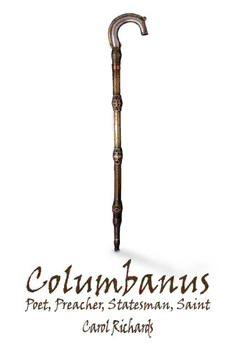
Columbanus PDF
Preview Columbanus
Contents APrayerfromStColumbanus iv 1 Columbanus:FatheroftheEuropeanUnion 1 2 EarlyLife 4 3 TheEgyptianInfluence 19 4 ChristianDruidism 40 5 WhydidColumbanusleaveIreland? 54 6 WhendidColumbanusleaveIreland? 63 7 TheSonsofLothar 83 8 TheNeroandHerodofOurTimes 91 9 WhoMurderedKingChilperic? 102 10 Backwoodsmen 113 11 RuleandPenitential 129 12 ThePerfectDiplomat 139 13 Shipwreck 156 14 TheConstantSea 172 15 ANewStart 186 16 TheRoadtoRome 193 17 TheFameofMortalLife 205 References 213 Index 215 Columbanus Poet,Preacher,Statesman,Saint CarolRichards imprint-academic.com Copyright©CarolRichards,2010 Themoralrightsoftheauthorhavebeenasserted. Nopartofthispublicationmaybereproducedinanyform withoutpermission,exceptforthequotationofbriefpassages incriticismanddiscussion. PublishedintheUKby ImprintAcademic,POBox200,ExeterEX55YX,UK PublishedintheUSAby ImprintAcademic,PhilosophyDocumentationCenter POBox7147,Charlottesville,VA22906-7147,USA 2015 digital version by Andrews UK Limited www.andrewsuk.com PassagesfromCardinalTómasO’Fiaich,ColumbanusinhisOwn Words,VeritasPublications,Dublin,1974/1990;usedwithper- mission. CopyrightmaterialfromTheHistoryoftheFranksbyGregoryof Tours,translatedwithandIntroductionbyLewisThorpe, PenguinClassics,1974;usedwithpermission. QuotationsfromEcclesiasticalHistoryoftheEnglishPeople,edited byJudithMcClure&RogerCollins,OUP,1999;bypermissionof OxfordUniversityPress. QuotationsfromLostScriptures,byBartD.Ehrman,OUP,2003; bypermissionofOxfordUniversityPress,Inc. APrayerfromStColumbanus Grant,OLord,thatthelightofyourlove mayneverbedimmedwithinus. Letitshineforthfromourwarmedheartstocomfortothers intimesofpeaceandinseasonsofadversity andinbrightbeamsofyourgoodnessandlove maywecomeatlasttothevisionofyourglory throughChristourLord.Amen. Chapter 1 Columbanus Father of the European Union … to live without offence, each retaining what he has receivedand“remainingwhereinhehasbeencalled”. Columbanus, LettertothenewlyelectedPope(604or607AD)1 InseekingtoexplaintheconceptofmodernEuropeanunity one of its founding fathers, Monsieur Robert Schuman, described a sixth century wandering Irish monk as ”the patron saint of those who seek to construct a united Europe”(Lehane,2005). He was speaking of the saint known as Columbanus —although he referred to himself as Columba—which in Latinmeans“TheDove”—theLatinsuffixwasaddedlater todistinguish himfromhisoldercontemporaryColumba ofIona,whomforthesakeofconveniencewewillhereafter refer to by his other name Columcille (”The Dove of the Church”). The addition of the suffix to the name of Columba the Youngerasheisalsosometimesknownindicatesthatacen- turyaftertheirdeathstheirliveshadalreadybecomesome- [1] “Thisiswhattheholyfathers,namelyPolycarpandPopeAnicetus taught—to live without offence to the faith, nay persevering in perfectcharity—eachretainingwhathehasreceivedand‘remaining whereinhehasbeencalled’”(O’Fiaich,1990,p.77).Cf.StPaul:“Let every man abide in the same calling wherein he was called” (1Corinthians7.20). 2 Columbanus what confused.2 It is instructive that both men chose the same monastic name because the chances are they left Irelandunderverysimilarcircumstancestoredeemthem- selvesinmissionaryactivities. However,whatwedoknowforcertainis,thatColumcille searchedforhisredemptioninthewesternislesofScotland andthatsignificantlyhedidnotgoveryfarfromIrelandor exilehimselfforlife.Columbanus,ontheotherhand,went intopermanentexileinperegrinatione. Inthecontextofthe lifeofasaintthisisusually translatedas“onpilgrimage” but peregrinaggio3—the Italian form of the word—is also translated as “travels and adventures” a description that might be better applied to the story of Columbanus’ life, althoughthespiritualelementwasneverfarfromthesur- face,andonewhichmightbeofmoreusetouswhenexam- iningthemotivesbehindhismission. His travels and adventures, in the course of a long life, tookhimfromBrittanyinthewestrightuptheRhinevalley acrosstheSwissAlpsintoLombardy—whatisnownorth- ernItaly—finallycomingtorestatBobbiowhere,aftercre- atinghislastfoundation,hediedattheageofseventy,for thetimeaveryoldman. Hewasthereforetheepitomeofthe“wanderingmonks” whocarriedacrossEuropetheirbrandofCelticChristianity which,evenmoreinterestingly,camebackbymoreorless the same route many centuries later in the form of the ProtestantReformation. For us, Columbanus holds the secret to the intellectual and spiritual schism that lies at the heart of the Europe M. Schuman4 was so keen to unite. For many centuries attemptshavebeenmadetocreateaunitedEurope. Many [2] TofurtherconfusemattersanotherColumbatheYoungerwasalso amongthegroupthataccompaniedColumbanus. [3] Cfthe1557VenetianbookPeregrinaggioditregiovanifiglivolidelRedi Serendippo byChristoferoArmenotranslatedas“TheTravels and Adventures of Three Princes of Serendip” (Merton & Barber, Princeton,2004). [4] RobertSchuman(1886–1963),aFrenchstatesmanandadrivingforce behindtheEuropeanCoalandSteelCommunitythatdevelopedinto theEuropeanUnion. Columbanus 3 times the attempt, however successful for a period, has ultimatelyfailed.Itssuccessorfailure,eveninthetwenty- firstcentury,mayequallybelaidatthedoorofthistemper- amentally volatile itinerant Irishman—typically Irish—a handsome man with a poetic temperament, volcanic temperandamindrigorousinpursuitofintellectualsatis- faction. Columbanus, as father of the Protestant Reformation, may be said to have destroyed the European unity of the MiddleAges. It’sironicthatheisnowsaidtobetheinspira- tion for its unity in its modern form. However, in a sense both claims are perfectly justified as he continues to be revered as a saint by both Protestants and Catholics in roughlyequalmeasuresandIwilltryandunravelthispara- doxbytellinghisextraordinaryandfascinatingstory. Chapter 2 Early Life Spurnnowthesweetdeceitsoflifebelow SoftLustcanuprightvirtueoverthrow… Columbanus,ToHunaldus1 In the first place we should examine what is meant by a saint.Notallsaintsaremartyrswhodiedfortheirfaith. A saint in the early days of Christianity was simply someonewhobelongedtothechurch—hencethe“Ibelievein the communion of saints” in the Apostles’ Creed and the Puritan use of the term to indicate anyone who belonged to theirsect. By the early middle ages the termsaint had come to be attachedtoanyonewhohadspentalifetimeintheserviceof Christianity,whetherparticularlysaintlybymodernstan- dardsornot.Intheearlyliveswefindsaintsindulgingin somevery unsaintly activities. TheextenttowhichChris- tianitycametodominatetheBritishIslesisevidencedbythe largenumberofplace-nameswhicharededicatedtosaints. ItbecametheLandofSaints. Someoftheseearlysaintscanwithcertaintybeidentified aslocalpagandeities,spiritsofnature,whoweretranslated intoChristiansaintstolegitimisetheircontinuedworship,a practicethatinitselfisconsistentwiththetheologyofChris- tian Druidism,2 that brand of Christianity peculiar to the British Isles and Northern Europe and quite distinct from RomanCatholicism. Sincetherewasofficiallyonlyonewesternchurchbefore theProtestantReformation,attheoutsetbothversionswere [1] O’Fiaich,1990,p.97. [2] SeeChapter4. Early Life 5 essentiallycatholic.Inreality,however,therewerealways tworeligions—twospiritualtempers—andtheschismthat tookplace,althoughalongtimecomingwasprettymuch inevitable. StColumbanuswasamongthosecalledasaintbecause he spent his life dedicated to the pursuit of intellectual excellenceintheserviceofthechurch,notbecausehewas particularly“saintly”bynature. Ofhisearlylifenotmuchisknown.Hewasbornaround theyear543ADsomewhereontheCarlow-Wexfordborder inthesouthofIreland(modernEire).3 Thesocietyhewasbornintowasbasedonaruralecon- omy,aworldofshepherds,cattle-herders,and,asweknow fromthetaleoftheBrownBullofCooley,cattle-rustlers. It was essentially a feudal society ruled by a clutch of pettykings,manyprobablynotmuchmorethanprovincial chieftains,answerabletoanoverlord,theArdRi—theHigh KingofIreland—whoheldhiscourtatTara. Below him came a warrior-caste who in turn acted as overlordstotheirtenantsandserfs. Somewhere in the middle came a professional class of brehonswhowerelawyersandadministrators,doctorsand mostimportantlypoets. Thepoetwasnotjustanentertainer,althoughhewasthat too,butalsoamusician,andmusicwashighlyprizedinthe classical world as a form of higher mathematics. He was alsoagenealogist—averyimportantroleinasocietywhere everything is based on kinship—and an historian. A poet alsohadacertainlicencetocriticisehisbettersandanotable aspectofhisworkincludedthekindofcomicverseandsat- irethatlaterfounditsapogeeinEnglandinChaucer. Thevalueplacedonthepoeticartsmaybejudgedfrom thefactthatpoetrywasalsoregardedasaroyal,althoughat [3] Thereissomedisagreementregardinghisdateandplaceofbirthas follows:Lehane,2005,p.148,543AD;Cahill,1995,p.188,circa540AD inLeinster;O’Fiaich,1990,p.13,543ADonthebordersofCarlow andWexford;Durant,1950,p.532,543ADinLeinster;Dictionaryof IrishBiography,?543AD;OxfordCompaniontoIrishLiterature,?543AD borninLeinster;Woods,2000,“Columbanwasbornabout543in LeinstersomewhereneartheCarlow-Wexfordborder”.
